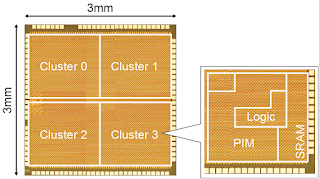Broadcom reported revenue of $5,517 million for its second quarter of fiscal year 2019, ended May 5, 2019, a decrease of 4.7 percent from $5,789 million in the previous quarter and an increase of 10.0 percent from $5,014 million in the same quarter last year. Gross margin was $3,089 million, or 56.0 percent of net revenue. Net income, which includes the impact of discontinued operations, was $691 million, or $1.64 per diluted share. This compares with net income of $471 million, or $1.12 per diluted share, in the prior quarter, and net income of $3,733 million, or $8.33 per diluted share, in the same quarter last year.
Semiconductor solutions represent 74% of revenue, while infrastructure software represented 26% of sales.
 "We executed according to plan in the second quarter with tailwinds from networking offsetting the anticipated headwinds from wireless," said Hock Tan, President and CEO of Broadcom Inc. "We currently see a broad-based slowdown in the demand environment, which we believe is driven by continued geopolitical uncertainties, as well as the effects of export restrictions on one of our largest customers. As a result, our customers are actively reducing their inventory levels, and we are taking a conservative stance for the rest of the year. We remain well-positioned across our various semiconductor and software businesses and are confident this portfolio of franchises will continue to drive sustained long-term revenue growth and increasing free cash flow."
"We executed according to plan in the second quarter with tailwinds from networking offsetting the anticipated headwinds from wireless," said Hock Tan, President and CEO of Broadcom Inc. "We currently see a broad-based slowdown in the demand environment, which we believe is driven by continued geopolitical uncertainties, as well as the effects of export restrictions on one of our largest customers. As a result, our customers are actively reducing their inventory levels, and we are taking a conservative stance for the rest of the year. We remain well-positioned across our various semiconductor and software businesses and are confident this portfolio of franchises will continue to drive sustained long-term revenue growth and increasing free cash flow."
"We achieved record free cash flow of $2.5 billion growing 20% year over year in the second quarter," said Tom Krause, CFO of Broadcom Inc. "Despite the challenging market backdrop and updated revenue outlook, we still expect to grow free cash flow by a double-digit percentage for the year. In addition, we remain focused on completing a total of $8 billion of share repurchases and eliminations in fiscal 2019.
On a conference call Hock Tan, President and CEO of Broadcom said:
A recovery had been expected in 2H19, but the U.S. / China trade tensions, and the Huawei ban in particular, has caused global equipment suppliers to cut back on orders. Global OEM customers are very nervous even though North American and European spending on networking remains robust. In the short term, the Huawei ban will be very impactful to the overall market because there are no other qualified vendors able to step up as OEM suppliers. If the ban remain in place for over 6 months or so, he expacts a re-balancing of market share as other global OEM increase orders with Broadcom to meet market demand.
For 2H19, sales are expected to the $17.5 billion, representing a decline in the high single digits. He noted that Broadcom's fundamentals remain strong, that the high-end networking silicon segment remains strong notwithstanding the Huawei ban. He said the company is well positioned for 5G and that he is pleased with the ramp-up of Wi-Fi 6.
http://investors.broadcom.com/phoenix.zhtml?c=203541&p=irol-IRHome
Semiconductor solutions represent 74% of revenue, while infrastructure software represented 26% of sales.
 "We executed according to plan in the second quarter with tailwinds from networking offsetting the anticipated headwinds from wireless," said Hock Tan, President and CEO of Broadcom Inc. "We currently see a broad-based slowdown in the demand environment, which we believe is driven by continued geopolitical uncertainties, as well as the effects of export restrictions on one of our largest customers. As a result, our customers are actively reducing their inventory levels, and we are taking a conservative stance for the rest of the year. We remain well-positioned across our various semiconductor and software businesses and are confident this portfolio of franchises will continue to drive sustained long-term revenue growth and increasing free cash flow."
"We executed according to plan in the second quarter with tailwinds from networking offsetting the anticipated headwinds from wireless," said Hock Tan, President and CEO of Broadcom Inc. "We currently see a broad-based slowdown in the demand environment, which we believe is driven by continued geopolitical uncertainties, as well as the effects of export restrictions on one of our largest customers. As a result, our customers are actively reducing their inventory levels, and we are taking a conservative stance for the rest of the year. We remain well-positioned across our various semiconductor and software businesses and are confident this portfolio of franchises will continue to drive sustained long-term revenue growth and increasing free cash flow.""We achieved record free cash flow of $2.5 billion growing 20% year over year in the second quarter," said Tom Krause, CFO of Broadcom Inc. "Despite the challenging market backdrop and updated revenue outlook, we still expect to grow free cash flow by a double-digit percentage for the year. In addition, we remain focused on completing a total of $8 billion of share repurchases and eliminations in fiscal 2019.
On a conference call Hock Tan, President and CEO of Broadcom said:
A recovery had been expected in 2H19, but the U.S. / China trade tensions, and the Huawei ban in particular, has caused global equipment suppliers to cut back on orders. Global OEM customers are very nervous even though North American and European spending on networking remains robust. In the short term, the Huawei ban will be very impactful to the overall market because there are no other qualified vendors able to step up as OEM suppliers. If the ban remain in place for over 6 months or so, he expacts a re-balancing of market share as other global OEM increase orders with Broadcom to meet market demand.
For 2H19, sales are expected to the $17.5 billion, representing a decline in the high single digits. He noted that Broadcom's fundamentals remain strong, that the high-end networking silicon segment remains strong notwithstanding the Huawei ban. He said the company is well positioned for 5G and that he is pleased with the ramp-up of Wi-Fi 6.
http://investors.broadcom.com/phoenix.zhtml?c=203541&p=irol-IRHome





















